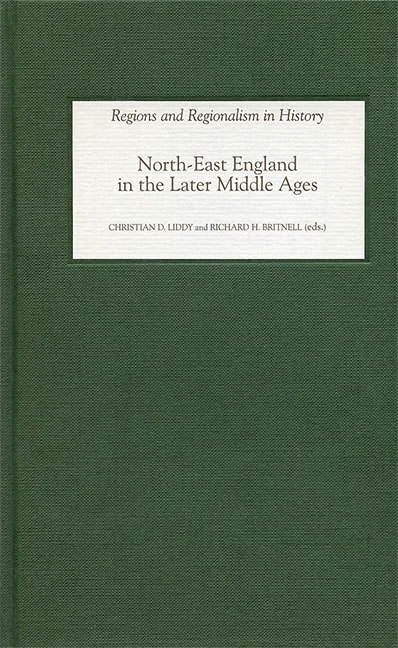Book contents
- Frontmatter
- Contents
- List of Illustrations
- Contributors
- Preface
- Abbreviations
- Introduction
- 1 St Cuthbert and the Border, c.1080–c.1300
- 2 John Hardyng, Northumbrian Identity and the Scots
- 3 Remembering the Legal Past: Anglo-Scottish Border Law and Practice in the Later Middle Ages
- 4 Scaling the Ladder: The Rise and Rise of the Grays of Heaton, c.1296–c.1415
- 5 Land, Legend and Gentility in the Palatinate of Durham: The Pollards of Pollard Hall
- 6 Local Law Courts in Late Medieval Durham
- 7 The Free Court of the Priors of Durham
- 8 Church Discipline in Late Medieval Durham City: The Prior as Archdeacon
- 9 Economy and Society in North-Eastern Market Towns: Darlington and Northallerton in the Later Middle Ages
- 10 Newcastle Trade and Durham Priory, 1460–1520
- 11 The Size and Shape of Durham’s Monastic Community, 1274–1539
- 12 Peasants, Landlords and Production between the Tyne and the Tees, 1349–1450
- 13 Wastes, the Margins and the Abandonment of Land: The Bishop of Durham’s Estate, 1350–1480
- 14 Framing Medieval Landscapes: Region and Place in County Durham
- Index
1 - St Cuthbert and the Border, c.1080–c.1300
Published online by Cambridge University Press: 23 March 2023
- Frontmatter
- Contents
- List of Illustrations
- Contributors
- Preface
- Abbreviations
- Introduction
- 1 St Cuthbert and the Border, c.1080–c.1300
- 2 John Hardyng, Northumbrian Identity and the Scots
- 3 Remembering the Legal Past: Anglo-Scottish Border Law and Practice in the Later Middle Ages
- 4 Scaling the Ladder: The Rise and Rise of the Grays of Heaton, c.1296–c.1415
- 5 Land, Legend and Gentility in the Palatinate of Durham: The Pollards of Pollard Hall
- 6 Local Law Courts in Late Medieval Durham
- 7 The Free Court of the Priors of Durham
- 8 Church Discipline in Late Medieval Durham City: The Prior as Archdeacon
- 9 Economy and Society in North-Eastern Market Towns: Darlington and Northallerton in the Later Middle Ages
- 10 Newcastle Trade and Durham Priory, 1460–1520
- 11 The Size and Shape of Durham’s Monastic Community, 1274–1539
- 12 Peasants, Landlords and Production between the Tyne and the Tees, 1349–1450
- 13 Wastes, the Margins and the Abandonment of Land: The Bishop of Durham’s Estate, 1350–1480
- 14 Framing Medieval Landscapes: Region and Place in County Durham
- Index
Summary
The liquidation of the Cuthbertian interest in Scotland in the fourteenth and fifteenth centuries has been analysed in great detail by several historians, and the severe diminution of the value of the properties on the English side of the border in the same period has also been the subject of recent scrutiny. This essay addresses two questions relating to the evolution of the landed and spiritual interest of St Cuthbert in the border region up to 1300. The first concerns the nature of the properties and rights St Cuthbert possessed in north Northumberland and southern Scotland c.1300 and the extent of their potential income yield. The second is to consider why the success evident in 1300 was in fact much less than was originally hoped and striven for in the late eleventh and early twelfth centuries. In dealing with these matters, it is important to recognise that, as a result of the foundation of the Benedictine chapter of Durham Cathedral in 1083, the trusteeship of St Cuthbert bifurcated into two institutions: one headed by the bishop of Durham; the other, the cathedral priory of Durham. Although the monks attempted with considerable success to appropriate the role and to present themselves as the sole guardian, to exclude the bishop of Durham would be to distort and falsify the picture.
On the eve of the Three Hundred Years’ War between England and Scotland, which began on 26 March 1296, St Cuthbert, in the form of his trustees, was the major force (and in many parts the controlling force) in a triangle of territory that bestrode the border. The hypotenuse of this triangle was a thirty-mile stretch of coastline from Pease Bay in the north to Budle Bay in the south and its apex was at Cornhill on Tweed, fifteen miles up river from Berwick. It covered roughly 170 square miles, slightly more than half of them lying north of the border. It is worth noting, however, that the border only became fully significant after 1300: for the men of the late eleventh century St Cuthbert's property on either side of the Tweed had a unity that the post-1300 world was not prepared to allow.
Of the two Durham parties, the bishop had the more restricted interest, in that it was entirely confined to England, with one small exception.
- Type
- Chapter
- Information
- North-East England in the Later Middle Ages , pp. 13 - 28Publisher: Boydell & BrewerPrint publication year: 2005



